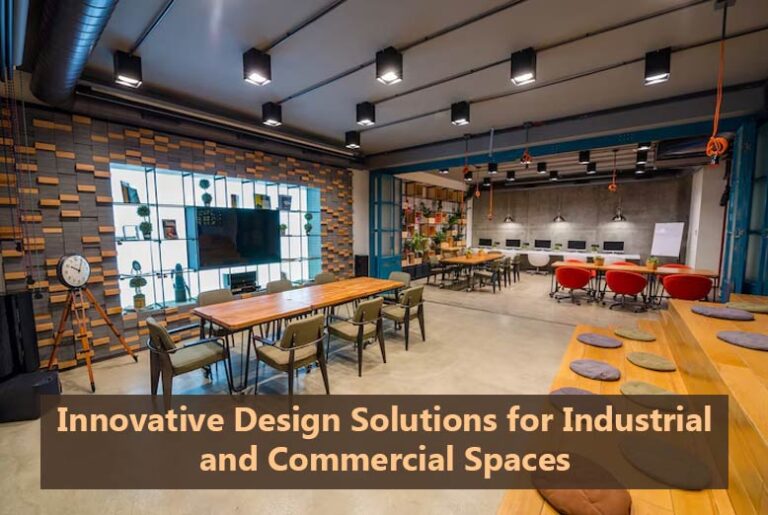In today’s rapidly evolving marketplace, industrial and commercial spaces must not only be efficient but also adaptable, sustainable, and aesthetically aligned with the company’s brand. Innovative design solutions are central to achieving these multifaceted goals, offering businesses a way to enhance their operational efficiency and workplace environment while minimizing their ecological footprint.
Sustainable Design Practices
As enterprises increasingly prioritize sustainability, the design of industrial and commercial spaces reflects this change. Architects and designers are now integrating energy-efficient systems such as solar panels, LED lighting, and smart thermostats to reduce energy consumption. Such systems not only lower utility costs but also contribute to a building’s overall environmental sustainability goals.
The selection of materials in construction projects also reveals a commitment to sustainability. Recycled steel, glass, and wood products are frequently used, reducing the demand on natural resources and decreasing the carbon footprint of manufacturing processes. Additionally, innovations like cool roofing materials and high-performance insulation improve building envelopes, enhancing their energy efficiency while supporting more controlled and comfortable indoor climates.
Beyond the use of sustainable materials and energy systems, water conservation practices are becoming integral to the design and operation of modern commercial facilities. Low-flow fixtures, water-efficient landscaping, and rainwater harvesting systems are employed to minimize water use. These features not only help conserve vital resources but also prepare businesses to adhere to increasingly stringent environmental regulations.
Optimizing Space for Flexibility and Efficiency
The layout of a space significantly influences its functionality. Dynamic, adaptable design elements such as movable walls and modular furniture allow businesses to alter their environments quickly and efficiently, accommodating evolving work requirements without extensive renovations. This flexibility is crucial for responding to changing market conditions and internal company developments.
Effective use of space also entails maximizing storage and minimizing clutter. Innovative storage solutions like multi-tiered shelving systems and automated retrieval systems optimize vertical space and improve inventory management. These systems facilitate faster access to tools and materials, streamline operations, and reduce the footprint required for storage, thereby freeing up more area for productive use.
Technology plays a pivotal role in the modernization of commercial spaces. From advanced conference room technologies that facilitate seamless global meetings to integrated systems that control lighting, temperature, and security, the infusion of smart technology improves both the efficiency and the security of industrial and commercial environments. These technologies not only support operational activities but also enhance the safety and comfort of those using the space.
Enhancing Productivity through Ergonomic Design
The well-being of employees is a critical consideration in workspace design. Ergonomically designed workspaces reduce physical stress and prevent injuries. Features like adjustable seating, standing desks, and strategically placed lighting are essential for creating a comfortable environment that can lead to increased productivity and reduced absenteeism.
The acoustics of a space also significantly affect worker productivity. In environments where concentration and communication are crucial, sound design elements such as acoustic panels and floors can mitigate disruptive noise. Such considerations are particularly important in open-plan offices and large industrial spaces where sound can travel freely and become a significant distraction.
Furthermore, appropriate lighting is crucial in any workspace. Natural lighting is incorporated wherever possible to boost morale and reduce energy costs, while adjustable artificial lighting systems ensure that employees can customize their environment to suit their needs. This tailored approach helps maintain focus and efficiency throughout the workday.
Building a Brand through Aesthetic Design
The aesthetic elements of a commercial space are powerful tools for branding. The design choices, from the colors and materials used to the furniture and art selections, all serve as reflections of the brand’s values and market position. These elements create a visual identity that can make a lasting impression on both employees and visitors, reinforcing the brand’s ethos and enhancing its market presence.
Strategic use of signage and wayfinding systems not only improves the functionality of a space but also serves as an extension of the brand identity. Well-designed, intuitive signage systems guide visitors fluidly through spaces, making their experience effortless and enjoyable. This attention to detail can significantly enhance the perception of a company’s professionalism and attentiveness to visitor and employee needs.
The design of the entrance and reception areas of a building is particularly impactful. These spaces set the tone for visitors’ perceptions and can be designed to create an inviting atmosphere that communicates a company’s values and attention to quality. High-quality materials and unique design features in these areas can make a strong statement about the company’s commitment to excellence and comfort.
Prioritizing Security and Accessibility
Security is a paramount concern in the design of industrial and commercial buildings. Advanced security systems including surveillance cameras, access control systems, and motion detectors are integrated into building designs. These systems not only enhance the security of physical assets but also provide a safer work environment for employees.
Accessibility is equally critical in building design, ensuring that all individuals, regardless of physical ability, can use the spaces effectively and comfortably. Features such as ramps, wide doorways, and accessible restrooms are standard practices in modern building codes. Ensuring these elements are not only functional but also aesthetically pleasing is a hallmark of thoughtful design.
Emergency preparedness is woven into the architectural fabric of modern buildings. Fire safety, in particular, is a critical component, and robust solutions are essential for ensuring a safe working environment. For instance, high-quality doors and frames, such as those provided by USA Fire Door, play a crucial role in fire safety. Their hollow metal doors and frames not only enhance building security but also contribute to the overall safety design, helping businesses meet rigorous safety standards.
Integrating Intelligent Building Technologies
Smart building technologies are transforming industrial and commercial spaces, making them more responsive and easier to manage. Building automation systems (BAS) control various functions such as lighting, climate, and security, optimizing these systems for both performance and cost-efficiency. The ability to monitor and control these systems remotely not only enhances management efficiency but also helps in maintaining a consistent environment optimal for business operations.
Building management systems are integral to maintaining the longevity and efficiency of building operations. These systems allow for centralized control and monitoring of building functions, including energy management and maintenance scheduling. This centralization can significantly reduce operating costs and increase the lifespan of building components by ensuring they are properly maintained and operated at optimal levels.
Data-driven management is becoming standard practice in the management of commercial spaces. Sensors and IoT devices collect data on everything from energy use to space utilization, providing managers with real-time information to make informed decisions. This approach not only improves building operations but also personalizes the working environment, potentially leading to greater employee satisfaction and productivity.
Advanced Lighting Solutions
Lighting design in commercial spaces involves much more than simply illuminating areas. Modern lighting solutions are designed to be energy-efficient and adaptable to the needs of the space. LED technology, coupled with smart lighting systems that adjust based on occupancy and natural light levels, reduces energy consumption while providing adequate lighting where and when it is needed.
Dynamic lighting systems enhance the functionality of a space by adjusting the lighting to meet specific requirements throughout the day. This can improve mood and productivity by mimicking natural light patterns, which helps maintain the circadian rhythms of the occupants.
In addition to functionality, lighting also plays a crucial role in the aesthetic and branding of a space. Custom lighting solutions can be used to highlight architectural features or artworks, contributing to the overall ambiance of the environment. This strategic use of lighting enhances the aesthetic appeal and can transform a simple space into a sophisticated and inviting environment.
Establishing Robust IT Infrastructure
In the digital age, the importance of robust IT infrastructure in commercial and industrial spaces cannot be overstated. High-speed internet connections are essential for modern business operations, facilitating everything from daily communications to complex cloud-based operations. Ensuring that these services are reliable and fast is paramount for business efficiency.
The design of server rooms and areas housing critical IT infrastructure must prioritize security, ventilation, and energy efficiency. Properly designed IT spaces prevent overheating and reduce the likelihood of system failures, which can be costly and disruptive to business operations.
Cable management solutions also play a crucial role in maintaining the aesthetics and functionality of office spaces. Well-organized cables not only enhance safety by reducing tripping hazards but also contribute to a cleaner and more orderly work environment. This organization is essential for maintaining the integrity and aesthetics of the workspace while ensuring easy access and maintenance of IT systems.
Minimizing Environmental Impact and Ensuring Compliance
Compliance with environmental regulations is a critical aspect of commercial and industrial building design. Staying abreast of local and international codes ensures that buildings are not only safe and efficient but also legally compliant. This compliance is crucial for avoiding legal penalties and for fostering public trust and corporate responsibility.
Implementing eco-friendly practices goes beyond compliance; it involves a commitment to reducing a building’s overall environmental impact. This can include measures such as optimizing building orientation to maximize natural heating and cooling, using sustainable materials, and incorporating energy-efficient technologies.
The design of a building also considers its impact on the local community. Engaging with community members during the planning stages can lead to designs that are not only more accepting to the public but also more integrated with the surrounding environment. This approach can enhance the public’s perception of a project and lead to more successful integration into the community, ultimately contributing to a project’s long-term success.
Finally, the design of industrial and commercial spaces is about much more than aesthetics and functionality. It involves a comprehensive approach that incorporates sustainability, technology, and flexibility to create environments that are efficient, safe, and pleasant to work in. By embracing innovative design solutions, businesses can ensure their spaces are equipped to meet the challenges of today and tomorrow.



